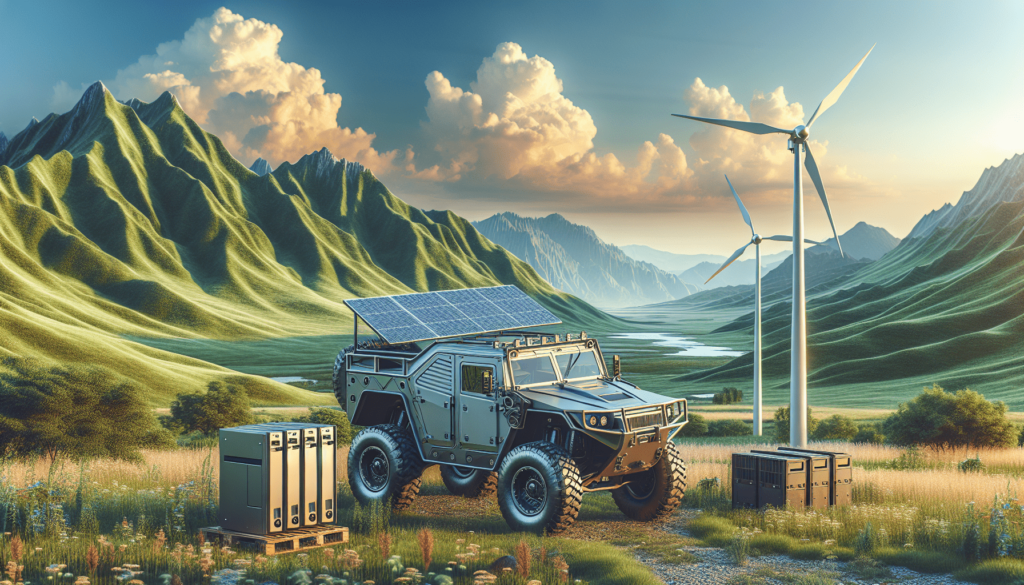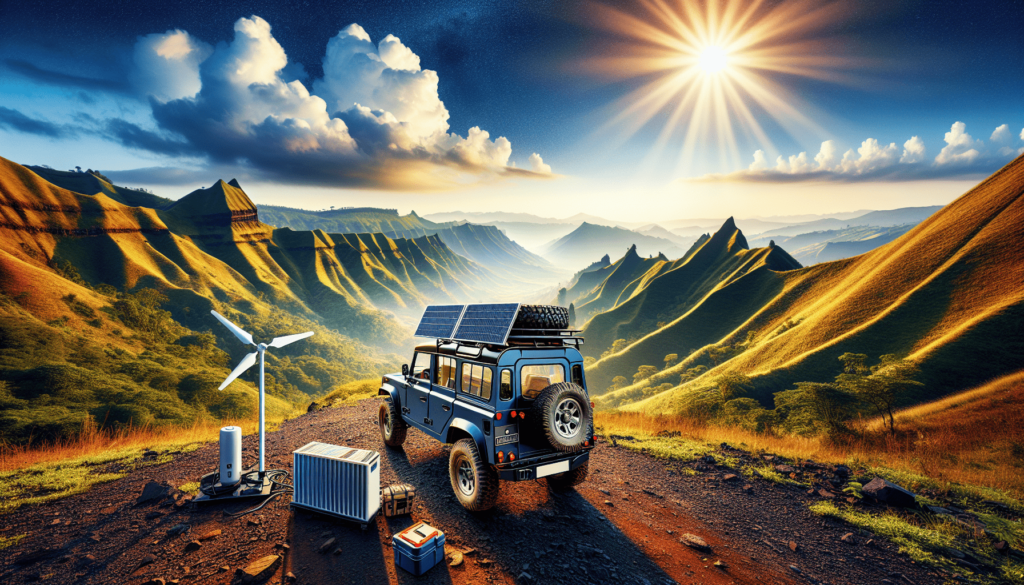How often do you think about how to power your overlanding adventures sustainably? As more people embrace the great outdoors, it is vital to consider how you can utilize renewable energy sources in your setup. This not only benefits the environment, but it can also enhance your experience by providing reliable and efficient energy options. Let’s explore how you can integrate renewable energy sources into your overlanding setup effectively.

Understanding Renewable Energy for Overlanding
When considering renewable energy, you’re likely looking at sources like solar, wind, and even bioenergy. These resources offer a sustainable way to power your trips without depleting natural resources or contributing to pollution.
What is Renewable Energy?
Renewable energy comes from sources that naturally replenish themselves over time, making them more sustainable than fossil fuels. For overlanding, the primary sources you’ll want to consider are solar panels and wind turbines. These technologies harness nature to provide you with power, so you can charge your devices and run your appliances while you’re on the road.
Why Choose Renewable Energy for Overlanding?
By choosing renewable energy, you’re not just reducing your carbon footprint but also gaining independence during your travels. Imagine not having to worry about gas stations or conventional power sources, instead relying on the sun or wind to keep your gear powered and ready. This independence allows you to stay out longer and explore more off-the-beaten-path destinations.
Solar Energy: The Go-To Option
Solar energy tends to be the most popular choice for overlanders due to its ease of use and effectiveness.
Benefits of Solar Energy
Solar panels offer numerous benefits for your overlanding setup, including:
- Simplicity: Solar panels are typically easy to install and operate, requiring minimal maintenance.
- Portability: Many solar systems are compact and can be set up anywhere there’s sunlight.
- Cost-Effective: While the initial investment can be significant, solar panels can save money in the long run by reducing fuel and electricity costs.
Choosing Solar Panels
When selecting solar panels for your setup, consider the following factors:
-
Type of Solar Panel: There are three primary types:
- Monocrystalline: Known for higher efficiency and lifespan, but usually at a higher cost.
- Polycrystalline: Often less expensive and efficiently performs well in high temperatures.
- Thin-Film: Lightweight and flexible but typically less efficient and larger than the other types.
-
Wattage: Calculate your energy needs based on the devices you want to power. A 100W solar panel might suffice for basic needs, while larger setups can require multiple panels.
-
Portability and Setup: Ensure you choose panels that are easy to transport and set up. Folding or portable options can be an excellent choice for overlanders who value convenience.
Setting Up Solar Panels
Once you’ve selected the right panels, you’ll need to set them up effectively:
- Placement: Find a sunny spot free from shade during the day.
- Angle: Position the panels at the right angle to maximize sun exposure. A tilt system can help adjust angles seasonally.
- Monitoring: Use a solar charge controller to monitor battery levels and manage energy efficiently.
Battery Storage and Inverter Needs
To store the energy collected by your solar panels, you’ll need a reliable battery system and inverter:
- Battery: Opt for deep-cycle batteries, such as lithium-ion or AGM (Absorbent Glass Mat), for effective storage. Look for a capacity that meets your energy consumption without draining too quickly.
- Inverter: If you plan to use AC devices, consider a power inverter to convert DC (from the battery) to AC. Make sure the inverter’s wattage matches your requirements.
Wind Energy: An Alternative Power Source
While solar is the most common energy source, wind energy can complement your setup, especially in areas with consistent winds.
Advantages of Wind Energy
Wind energy might not be suitable for every overlander, but if you travel to windy areas, it can offer:
- Continuous Power: Wind turbines can produce energy day and night, provided there’s wind.
- Reinforced Energy System: Using both solar and wind can provide more reliability in varying conditions, especially where one source may be less effective.
Selecting a Wind Turbine
When considering a wind turbine, look for:
- Size and Design: Smaller, portable wind turbines are perfect for overlanding. They should be lightweight and easy to set up.
- Output Rating: Similar to solar panels, check the wattage ratings to ensure it meets your electrical demands.
Setting Up a Wind Turbine
- Location: Position the turbine in a clear area that can harness wind uninterrupted by trees or structures.
- Height: Generally, the higher the turbine, the better it will perform. Some overlanders use mast systems to elevate their turbines.
Combining Solar and Wind: A Unified Approach
By combining both solar and wind energy, you can create a robust and efficient energy system for your overlanding adventures.
Benefits of Hybrid Systems
- Reliability: If solar panels aren’t generating enough power due to cloudy weather, wind turbines could pick up the slack.
- Optimized Energy Use: A hybrid system can capture energy from multiple sources, maximizing your energy portfolio.
Managing a Dual System
- Battery Management: Ensure your battery storage can handle energy from both solar and wind sources. This often requires advanced charge controllers.
- Energy Monitoring: Implement a monitoring system to track power flow and make adjustments as necessary to avoid overcharging or drained batteries.

Additional Renewable Energy Sources
While solar and wind are the most common, there are other options to explore for your overlanding setup.
Bioenergy
Biomass energy can come from organic materials, such as food waste or wood. If you have a campfire, you can use it to power a small generator, but it’s not always the most practical or consistent method for overlanding.
Hydropower
If you’re overlanding near rivers or streams, hydropower can be a feasible option as well. Micro-hydro generators can produce significant electricity with flowing water. However, the setup can be complicated and requires access to a flowing water source.
Energy Consumption: Evaluating Your Needs
Understanding how much energy your setup requires is crucial for selecting the right equipment.
Calculating Energy Needs
- List Your Devices: Start by making a list of all the electronic devices you plan to power during your trips around the world. This can include:
| Device | Wattage | Usage Time | Daily Consumption (Wh) |
|---|---|---|---|
| Refrigerator | 75-150 | 24 hours | 1800-3600 |
| Lights | 10 | 5 hours | 50 |
| Laptop | 60 | 4 hours | 240 |
| Phone Charger | 5 | 2 hours | 10 |
| Total | 2100-3830 |
- Daily Consumption: Calculate total daily watt-hours needed based on the wattage and usage time for each device. This will help guide what battery capacity and solar panel size you require.
Choosing the Right Equipment Based on Needs
Once you understand your daily needs, you can make informed decisions about your solar panels, wind turbines, and battery storage. Always consider choosing gear that provides a little extra capacity to account for fluctuations in energy production and usage.
Practical Considerations for Overlanding
Integrating renewable energy into your overlanding setup requires planning and practical considerations.
Budget
Setting a budget for your renewable energy system is vital. Consider the costs of:
- Solar panels
- Wind turbines
- Batteries
- Inverters
- Installation and hardware
Installation
Some systems can be set up in a few hours, while larger systems may take longer. Read up on your equipment and think about how comfortable you are with DIY projects.
Space and Weight Constraints
Integrating renewable energy means you have to consider space and weight in your vehicle:
- Solar panels can often be mounted on rooftops or on racks.
- Wind turbine systems may require additional space for setup and storage.
- Batteries and inverters take up space and add weight, which can impact your vehicle’s performance, especially if you’re off-roading.
Maintenance of Renewable Energy Systems
Keeping your renewable energy systems in good shape will ensure that they serve you well.
Routine Check-ups
- Solar Panels: Regularly clean your panels to prevent dirt buildup, which can impact efficiency. Inspect all connections for corrosion or wear.
- Wind Turbines: Check for any damage to the blades or housing, particularly after strong winds.
- Batteries: Monitor battery levels and check terminals for corrosion. If you notice significant drops in efficiency, it may be time to replace them.
Staying Informed
Stay updated on the latest technologies and best practices in renewable energy that could increase efficiency or reduce costs in your overlanding setup.
Overlanding Resources and Communities
To further your understanding and implementation of renewable energy, consider looking into overlanding communities and resources.
Online Forums and Social Media Groups
There are numerous online platforms where like-minded overlanders share their experiences and tips. Joining these communities can provide valuable insights and answers to questions you may have.
Workshops and Meet-ups
Participating in workshops or meet-ups related to overlanding and renewable energy can expand your knowledge and connect you with experts who can help you familiarize yourself with equipment.
The Future of Your Overlanding Setup
Incorporating renewable energy into your overlanding adventures opens up a world of possibilities. You’ll not only enjoy the great outdoors but do so in a way that is sustainable and responsible.
Additional Upgrades
As technologies evolve, consider upgrading systems as new advancements are made. Keeping your equipment modern ensures you’re utilizing the most efficient systems available.
Responsible Overlanding
Being mindful of your environmental impact while on the road solidifies your commitment to sustainability. Consider investing in other environmentally friendly technologies, such as water filtration systems and waste management devices, to further enhance your low-impact overlanding experience.
Conclusion
Integrating renewable energy sources into your overlanding setup doesn’t have to be overwhelming. By understanding the options available and carefully planning your energy needs, you’ll be able to power your adventures sustainably. Whether you choose solar, wind, or a combination of both, you’ll enjoy the freedom and independence that come from being powered by nature. Embrace this journey toward a greener and more responsible way to experience the great outdoors!

